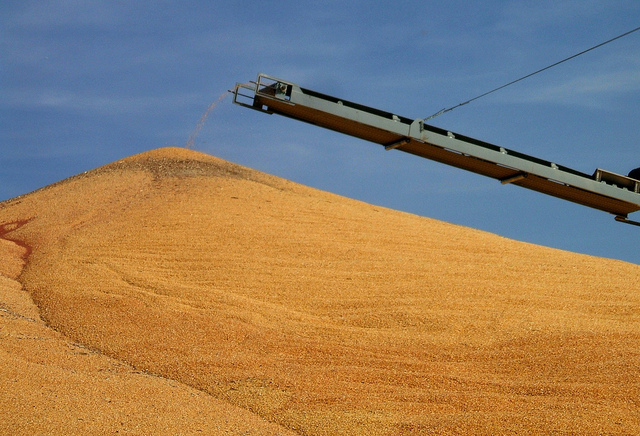
Nine billion is the number that will define the 21st century. That’s the number of people expected to live on this planet by 2045. But 9 billion mouths are a lot to feed, and each of them will hopefully have more than enough to eat. Achieving both goals—feeding 9 billion and feeding them properly—will be a herculean task. It’s also one that could eliminate the world’s great remaining forests, taking with them ecosystem services like carbon storage, reliable rainfall, biodiversity, and the magnificence of miles upon miles of wilderness.
So what if someone said it might be possible to ramp up food production while expanding forested land? Sounds like a perpetual motion machine, right? It smacks of the impossible. But that’s just what Eric Lambin and Patrick Meyfroidt are proposing in their paper which appears in the Proceedings of the National Academy of Science. They think that boosting agricultural intensity can not only increase agricultural output, but also reverse deforestation. In theory, doing more with less is a great way to solve the world’s problems, but these theories usually come with a catch. And Lambin and Meyfroidt’s catch is a big one—the radical globalization of the world’s food markets. It’s an intriguing proposal with some hard data to back it up, but the authors are also quick to brush aside the potential problems.
Globalization, Lambin and Meyfroidt claim, can focus farming where it is most productive. In their vision, different regions will specialize in different crops, eking the most out of every acre of cultivated land. Those crops will then be whisked across borders to where they are needed. It’s the exact opposite of every locally-harvested, free-range, organically-grown mantra that’s proposed to save the world.
The authors outline four facets of globalization that could help or harm the cause. The first, displacement, could go either way. Displacement essentially moves crop production and timber harvesting from one place to another. As rich nations seek to protect their forests, for example, they must import their timber from elsewhere. The same goes with food stuffs. In Switzerland, for instance, the land required to grow its imported food is one and a half times more than the country’s currently cultivated land. But displacement may not be all bad, they say. For every 20 hectares of forest protected in North America and Europe, for example, only about one hectare of primary forest is logged in Russia or the tropics.
The second proviso they cite is rebound. As a new technology becomes cheaper, demand for it will increase as it becomes cost effective for more industries. Cheap gasoline, for example, has led to a proliferation of gas-powered devices (think leaf blowers, lawn mowers, and so on). More efficient agriculture, Lambin and Meyfroidt state, could also be more lucrative agriculture, driving an expansion of cropland rather than a reduction. They point to soybeans in Brazil and oil palm in Indonesia and Malaysia as examples. But they also counter that agricultural intensification since 1961 has reduced the amount of land that otherwise would have been needed to feed the world’s people.
The third caveat of globalization is cascade effects, whereby one crop displaces another, exploiting previously uncultivated land. Biofuels are a case in point. As some farmers use their land to cash in on the craze, other land is put under the plow to produce food stuffs.
Remittances are the last side-effect of globalization, and one that seems to be a net positive. Foreign workers often send money back to family members still in their home country, and the added influx of cash reduces the need for farmland in that country. With supplemented incomes, people can afford to purchase more food as opposed to growing all of it. Since subsistence farming is not very intensive, people’s remittance-assisted diets rely on less land.
Lambin and Meyfroidt offer four examples of countries in which agricultural output has risen concomitant with population and the amount of forested land—China, Costa Rica, El Salvador, and Brazil. Each case appears to be fairly unique, though, and is not enough to convince me that globalization and intensification are the best solution. China, for example, has turned to Africa to help feed its 1.3 billion people, locking up over 28,000 square miles of farmland and counting. Costa Rica’s success has been dependent on foreign groups purchasing land for conservation (a sort of highfalutin remittance), while El Salvador relies on small-scale remittances. Furthermore, statistics on Vietnam’s and China’s forests have both benefitted from plantations, which some experts have called “ecological deserts” and poor substitutes for the real thing. Furthermore, Lambin and Meyfroidt admit that many other countries in similar circumstances have not seen an uptick in the amount of forested land.
The authors also gloss over a major pitfall of globalization—pollution. Currently, shipping releases 1.12 billion metric tons of CO₂ per year into the atmosphere, or more than Germany, the world’s sixth largest emitter. Transporting food all around the world will only drive that number up. With climate change threatening to upend farming as we know it, pumping more CO₂ into the atmosphere may not be the best idea. That’s not to say the proposal is worthless—nine billion people are an awful lot to feed, after all—but there are some big questions that need to be answered before it should be seriously considered.
Source:
Lambin, E., & Meyfroidt, P. (2011). Inaugural Article: Global land use change, economic globalization, and the looming land scarcity Proceedings of the National Academy of Sciences DOI: 10.1073/pnas.1100480108
Photo by ConanTheLibrarian.
Related posts: